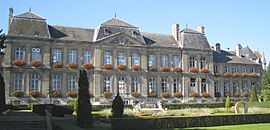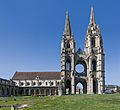Soissons facts for kids
Quick facts for kids
Soissons
|
||
|---|---|---|
|
Subprefecture
|
||

City hall
|
||
|
||
| Country | France | |
| Region | Hauts-de-France | |
| Department | Aisne | |
| Arrondissement | Soissons | |
| Canton | Soissons-1 and 2 | |
| Intercommunality | GrandSoissons Agglomération | |
| Area
1
|
12.32 km2 (4.76 sq mi) | |
| Population
(2021)
|
28,705 | |
| • Density | 2,330.0/km2 (6,034.5/sq mi) | |
| Time zone | UTC+01:00 (CET) | |
| • Summer (DST) | UTC+02:00 (CEST) | |
| INSEE/Postal code |
02722 /02200
|
|
| Elevation | 38–130 m (125–427 ft) (avg. 55 m or 180 ft) |
|
| 1 French Land Register data, which excludes lakes, ponds, glaciers > 1 km2 (0.386 sq mi or 247 acres) and river estuaries. | ||
Soissons (pronounced swa-SON) is a city in northern France. It is located in the Aisne department, part of the Hauts-de-France region. Soissons sits on the Aisne river, about 100 kilometers (62 miles) northeast of Paris. It is one of France's oldest towns. It was likely the ancient capital of the Suessiones people. Soissons is also home to an old Roman Catholic diocese, which started around 300 AD. Many important church meetings, called "Councils of Soissons," happened here.
Contents
History of Soissons
Soissons first appears in written records with its Celtic name, Noviodunum. This name means "new hillfort." It was the capital city of the Suessiones tribe. When the Romans arrived, it was a town of the Suessiones. Julius Caesar mentioned it in his writings.
Caesar visited Noviodunum in 57 BC. He described it as a town surrounded by a high wall and a wide ditch. The town surrendered to Caesar's forces.
The Kingdom of Soissons
From 457 to 486 AD, Noviodunum was the capital of the Kingdom of Soissons. This kingdom was led by Aegidius and his son Syagrius. In 486, the Frankish king Clovis I took over the kingdom. This happened after the Battle of Soissons.
Soissons became part of the Frankish territory called Neustria. The city and the Abbey of Saint-Médard were very important. The abbey was founded in the sixth century. They played a big role during the rule of the Merovingian dynasty (447–751).
After Clovis I died in 511, his lands were divided into four kingdoms. Soissons became the capital of one of these kingdoms. Eventually, the kingdom of Soissons disappeared in 613. This happened when all the Frankish lands joined under Chlothar II.
Important Meetings and Wars
In 744, an important meeting called the Council of Soissons took place. It was arranged by Pepin the Short and Saint Boniface. They were important church leaders. This meeting led to the condemnation of two bishops, Adalbert and Clement of Ireland.
During the Hundred Years' War, French soldiers attacked English archers in Soissons. This event was very shocking. Henry V of England later claimed to get revenge for this at the Battle of Agincourt in 1415. The town was later freed by French troops. This happened on July 23, 1429, led by Joan of Arc.
Between 1728 and 1729, Soissons hosted the Congress of Soissons. This meeting tried to solve problems between Great Britain and Spain. It helped end the Anglo-Spanish War of 1727–1729. The meeting was successful and led to the Treaty of Seville.
Soissons in World War I
During World War I, the city was heavily bombed. A statue stands behind St. Peter's Church. It honors French soldiers who died in 1917. This statue is next to the Soissons Courthouse.
What to See in Soissons
Today, Soissons is a center for business and manufacturing. It has several important historical sites. These include the 12th-century Soissons Cathedral, the ruins of St. Jean des Vignes Abbey, and the crypt of the old Saint-Médard Abbey. The nearby Espace Pierres Folles has a museum, a geological trail, and a botanical garden.
Famous Buildings and Sites
- Soissons Cathedral is built in the Gothic architecture style. Work on the south transept began around 1177. The choir was finished in 1211. This was even earlier than the famous Chartres Cathedral. Building continued on the nave until the late 13th century.
- Abbey of Notre Dame was a royal abbey. It was founded during the Merovingian era. The abbey was known for its many important relics. These included the "shoe of the Virgin." Famous abbesses led the abbey. These included Gisèle, who was the sister of Charlemagne.
- Saint-Médard Abbey was a Benedictine monastery. It was founded in the sixth century. Today, only the crypt of the abbey remains.
- Hôtel de ville (City Hall) has been in its current building since 1833. The building was a chateau. It was built between 1772 and 1775.
- Arsenal is an exhibition space. It is located in the old arsenal of the former Abbey of St. Jean des Vignes.
- Passerelle des Anglais (Footbridge of the English) is a concrete footbridge over the Aisne river. The first bridge was destroyed in 1914. British soldiers rebuilt it, and it became known as the "Bridge of the English." It was destroyed again in World War II. It was rebuilt in 1950 as a bridge just for people walking.
- The Covered Market was built in 1908. The architect was Albert-Désiré Guilbert.
Famous People from Soissons
Many notable people have connections to Soissons:
- The actress Aurore Clément was born in Soissons in 1945.
- The artist Emmanuel Fillion was born in Soissons in 1966.
- Shemaiah of Sossoines was a rabbinic writer from the 11th century. He was a main student of Rashi.
- The saints Crispin and Crispinian died in Soissons around 286 AD. They were preaching Christianity to the local people.
- The 6th-century Burgundian king Guntram was born in Soissons around 532.
- Jeanne Macherez (1852–1930) was a heroine during World War I. She was also the Mayor of Soissons.
Population of Soissons
The population of Soissons has changed over many years. Here is a look at how the number of people living in the city has grown and shrunk:
| Historical population | |||||||||||||||||||||||||||||||||||||||||||||||||||||||||||||||||||||||||||||||||||||||||||||||||||||||||||||||||||
|---|---|---|---|---|---|---|---|---|---|---|---|---|---|---|---|---|---|---|---|---|---|---|---|---|---|---|---|---|---|---|---|---|---|---|---|---|---|---|---|---|---|---|---|---|---|---|---|---|---|---|---|---|---|---|---|---|---|---|---|---|---|---|---|---|---|---|---|---|---|---|---|---|---|---|---|---|---|---|---|---|---|---|---|---|---|---|---|---|---|---|---|---|---|---|---|---|---|---|---|---|---|---|---|---|---|---|---|---|---|---|---|---|---|---|---|
|
|
||||||||||||||||||||||||||||||||||||||||||||||||||||||||||||||||||||||||||||||||||||||||||||||||||||||||||||||||||
| Source: EHESS and INSEE (1968-2017) | |||||||||||||||||||||||||||||||||||||||||||||||||||||||||||||||||||||||||||||||||||||||||||||||||||||||||||||||||||
Images for kids
See also
 In Spanish: Soissons para niños
In Spanish: Soissons para niños






